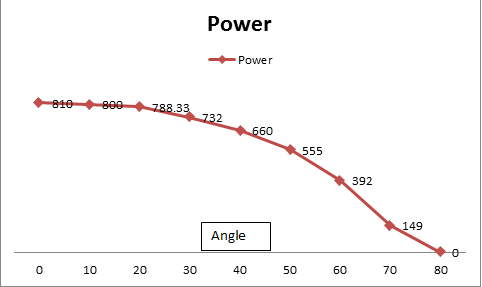Solar
energy is collected by extracting energy from solar radiation using solar
cells. The energy collected important to expanding our sources of alternative energy.
Currently solar energy is low on the spectrum for energy production. According
to the Energy Information Administration only solar energy only produces 0.4% of
the world’s energy by 2014[Major energy Sources]. By figuring out how to maximize the
efficiency of solar cells people and engineers can build better setups for
homes and even in solar farms.
Panels
in solar farms are usually anchored in one direction. Their angle of incidence
to the sun stays the same until they are changed depending on the season. This
is effective but the panels are only at their peak performance during a specific
time of the day, when the sun is perpendicular to the solar panels.[Optimum
Tilt of Solar Panels]. Most solar panels are built in a horizontal position, so
the tilt is not a problem.. The way the tilt is usually calculated is by making
it 5° greater than the latitude of the general location it is placed. [The
effect of Seasonal Variation and Angle…]. The size of a solar panel can also be
affected by the location. An example given was San Diego San Diego has a
latitude of 33° which means that they are able to reduce the size of panels
because it gives a larger exposer of sun. [How does the tilt angle effect
system performance]
The
objective of my experiment was to find a distinct relationship between a solar
cells power output its angle of incidence to the sun. I predicted that the
solar cells would maintain a linear output until the angle became more radical
and then start to fall off quickly. To set up my experiment I climbed a
mountain where the sun was clear and un-obstructed thorough the day. I used a
set of three solar cells attached to a backpack the three cells were already
linked together and shared one output lead, therefor adding the voltage,
current, and power they produced. Then I set up a two foot tall by 1 foot wide cardboard
box lined in black paper to set over the backpack this was so any ambient light
reflected from the ground would not be absorbed by the solar cells. Starting at
approximately at 12:00 P.M I pointed the apparatus (solar cells and cardboard
shield) to the sky and tested the output using a multi-meter for every degree
of change (10° per change), I used a protractor to measure the angle . I
collected data on the voltage, current and power up until 80°, after this point
the data was unimportant because the decline was easily seen.
All of the data was collected at
the same time through the use of a
multi-meter which uses two leads to find the power current and voltage in
electrical equimpent. In order to find the measurements I simply touched the
leads to the output cord on the backpack. But to find the current I needed to
use a small lightbulb. I connected one lead to the lightbuld and then the
lightbulb to the solar panels then another lead from the panels back to the
multi- meter. This was so the electricity produced could travel through more
than just the two objects, this is needed to read current.
The
results to my experiment were as expected, the graphs remained fairly linear
until it reached an expected threshold (about 40°) and after wards a very steep
decline happens. I believe the experiment went well. The day was not cloudy so
there were no uncontrollable obstructions.
If there was anything I could to improve on my results I believe that slight
upgrades to my equipment would be best. this test were to be done in an area
closer to the equator where the sun is more powerful, as well as if I used a
type of black fabric instead of paper to line my cardboard shield I think the
absorption would have been better because I could see slight reflection on the
papers surface. My solar cells and multi-meter were also not entirely
professional, but other than these small equipment changes the experiment could
not have gone any better.
Cites:
1.
"U.S.
Energy Information Administration - EIA - Independent Statistics and
Analysis." What
Is U.S. Electricity Generation by Energy Source? U.S
Department of Energy, 31 Mar. 2015. Web. 08 Apr. 2015.
2.
Landau, Charles L.
"Optimum Tilt of Solar Panels." Optimum
Tilt of Solar Panels. N.p., 16 Apr. 2014. Web. 08 Apr. 201
3.
N.V. Ogueke, F. Abam, K. N. Nwaigwe, C.A. Okoronkwo, P.E. Ugwuoke
and E.E. Anyanwu, 2013. The Effect of Seasonal Variation and Angle of
Inclination on the Performances of Photovoltaic Panels in South Eastern
Nigeria. Research Journal of Applied Sciences, Engineering and
Technology, 5(03): 794-800.
4.
B. Kamanga, J. S. P. Mlatho, C. Mikeka, and C. Kamunda,
“Optimum Tilt Angle for Photovoltaic Solar Panels in Zomba District, Malawi,” Journal of Solar Energy, vol. 2014,
Article ID 132950, 9 pages, 2014. doi:10.1155/2014/132950
5.
Zhou, Yutao, and Dan Frering. "How Does the
Tilt Angle And/or Orientation of the PV Panel Affect System Performance?"
Lightening Research Center. Ensselaer Polytechnic Institute, July 2006. Web. 08
Apr. 2015.



No comments:
Post a Comment